
Hi Gang…
This is the second in a series of articles on the 1949 Edwards R26 sports car. You can review all stories about this and other Edwards sports cars here on Forgotten Fiberglass by clicking here.
I’ve been focusing on the Sterling Edwards 1949 R26 sports car of late because it influenced expectations across America concerning the promise and design of this new category of cars in the immediate postwar era.
Another reason for covering this now is that the car (the Edwards R26 with its original body but on a completely different chassis) is coming up for auction in November 2011. Click here to read more about the car and the auction near Chicago, Illinois.
As I’ve said before, it’s an exciting time to learn about these early postwar American sports cars, so let’s take a look at what Motor Trend had to say about one of America’s first postwar sports cars in January 1950.
Reversing A Trend
Motor Trend, January 1950
Reversing a trend of building individual sports cars for use only in this country, Sterling Edwards of Hollywood, California, has produced a custom-built car that will be used on road race courses throughout Europe this Spring. As conditions stand now, the car will not be placed in production, since it is intended only for Edwards’ personal use.
Although a Ford V8 “60” is used for the power plant, the car was designed for competition in Formula B classification (2 liters – 122 cubic inches). To make the car eligible for this class, Edwards intends to sleeve the cylinder and to de-stroke the crankshaft, thereby bringing the cubic inch displacement down to the maximum allowable.
The original drawings of the car were made by Edwards; then with the assistance of Norman Timbs of Van Nuys (cover car, October ’49) he began to plan out the car. From the drawing board, an exact scale wooden model was built up from which the body lines were worked out.
A small traveling overhead crane with a pointer was used to pick up the various stations from the model. These locations were then transposed onto a wooden mockup. Aluminum alloy sheets were then pounded out and accurately fitted to the mockup.
In the meanwhile, the running gear was assembled and comprehensively tested on a race track. After this testing period, the body was fitted to the chassis and the final assembly was made.
Production of the chassis began in January 1948, while the body was started in June 1949. Four months later, the S-E Sports Car was standing complete in Diedt & Lesovsky garage, an automotive engineering firm in Los Angeles.
Possibly the most interesting feature of the S-E Sports Car is the tubular frame, using independent suspension at all four wheels. The side members consist of chrome-moly tubing, .083 inch wall thickness by four-inch diameter.
There are three main cross members – fore and aft of the engine and the third forward of the rear axle (the latter two are also four-inch chrome-moly tubing.)
“A” frames and coil springs are used for front wheel suspension, while transverse torsion bars (3/4 inch diameter by approximately 2 and ½ feet) are used in conjunction with the de Dion swing axle at the rear. The rear axle is suspended by brackets supported by the false frame aft of the rear cross-member.
The suspension of the car is such that a rear wheel can be jacked up and the corresponding front wheel will also lift off the ground. Houdaille shocks are used at al four wheels. Tires are 5.50 x 15 in front and 6.40 x 15 in the rear. The conventional hydraulic brake system is used. The power plant is a Ford V8 “60” of 154 cubic inch displacement. The engine has been ported and relieved, uses Eddie Meyer heads of 10:1 compression ratio and a dual manifold. The ignition is by Meter, while spark plugs are Champion J-6.
A stock exhaust manifold is used; however, a cutout permits by-passing of the muffler when the car is used in races. Overhead valves, of the BMW type, are now being made for the engine by Norman Timbs. The radiator has a large frontal area of .371 square inches and a core thickness of three inches.
The wheelbase of the S-E Sports Car is 100 inches, while the tread is 52 inches, front and rear. Without the top, but with a full fuel tank (30 gallons) the car weighs 2380 pounds. The interior of the car, designed and fitted by Dale Runyan of Hollywood, should satisfy the most critical eye.
Maroon genuine leather covers the solid airfoam cushions on the specially constructed seats, while the floor mat is made from Wilton maroon carpeting material.
A two-inch leather covered crash pad circles the entire cab area, including the doors and the dash panel. The doors are also padded and are covered with maroon genuine leather. The dash panel includes only two circular instruments, a push-button radio, and twelve control handles.
The two instruments are from a late model Nash, with the left dial including a tachometer, oil pressure, water temperature, and fuel pressure gauges. The right dial includes the speedometer, ammeter and fuel gauge.
The identical control handles are for spark, water injection, electric radiator fan, choke, turning light, headlights, heater, wiper, cold air and cigar lighter. The steering wheel and column shift are from a Studebaker Champion.
For racing purposes, the car is stripped of all unnecessary items, such as the battery, bumpers, and rear seat. The rear seat compartment can be enclosed by a special metal cover. The top is removable, being held on by toggle fasteners. The windshield can also be removed and is replaced by a small racing-type shield.
The performance of the S-E Sports Car should assure its appearance among top finishers in any road race. Acceleration, braking and cornering characteristics are particularly fine, while in normal traffic, fuel consumption is around 22 mpg.
It will be interesting to watch this car in competition with some of the better-known foreign sports cars, against which it should make more than just an impression.
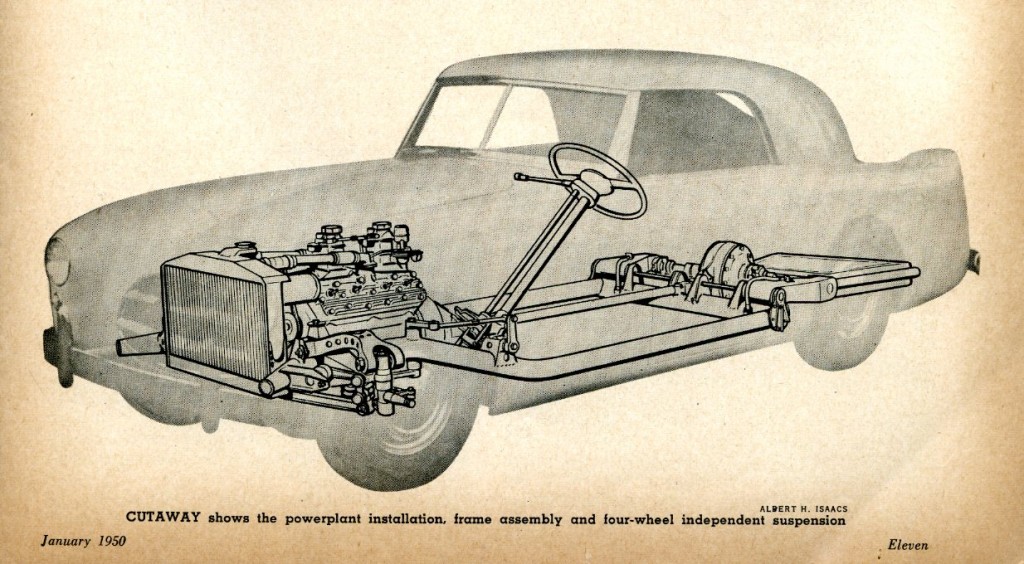
Caption: Cutaway shows the power plant installation, frame assembly and four-wheel independent suspension.
Summary:
It’s interesting to note that the car had a rear seat. Most of the pictures I’ve seen show just the two-seat configuration. I’m still looking for a good picture that shows this front/rear seat configuration.
And somehow I love the idea that one of America’s first custom built sports / race cars came with an AM push-button dash and a cigar lighter. I guess when the race was over – you hit the streets right from the Winner’s Circle. No need to load your car – off and away you went!
What fun it must have been to be a part of this special era of sports and race car building in early postwar America.
Hope you enjoyed the story, and until next time…
Glass on gang…
Geoff
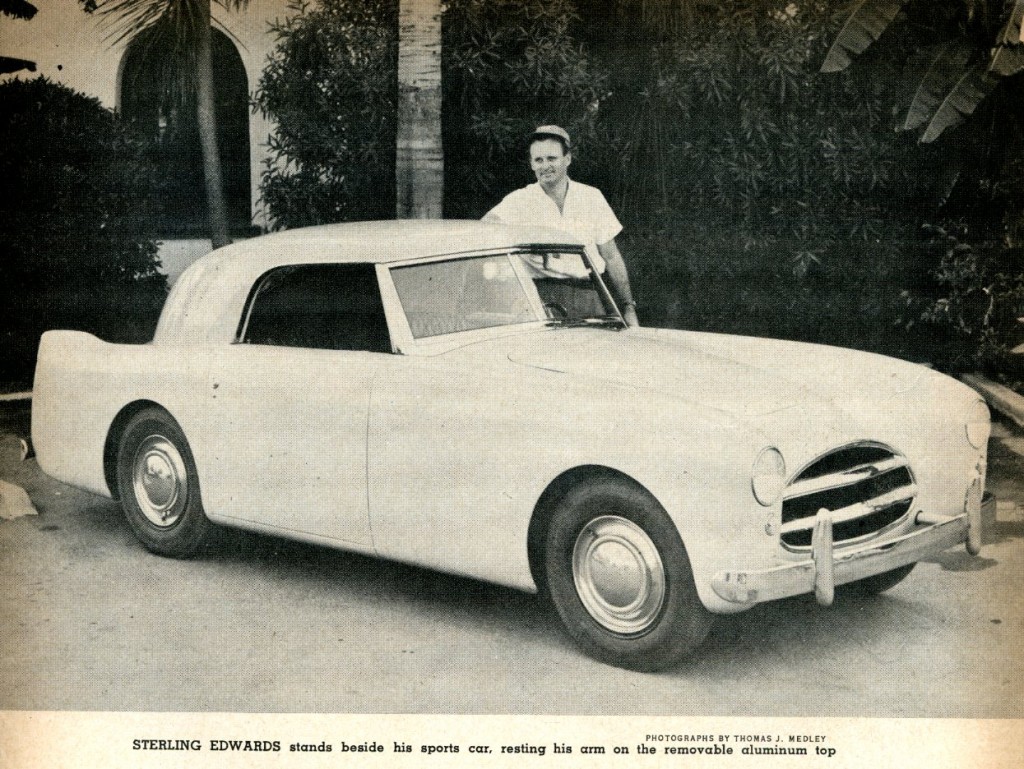
Caption: Sterling Edwards stands besides his sports car, resting his arm on the removable aluminum top.
——————————————————————-
Click on the Images Below to View Larger Pictures
——————————————————————-
- Caption: Interior by Dale Runyan includes maroon genuine leather.
- Caption: Power plant of S-E Sports Car is Eddie Meyer Ford V8 “60”
- Caption: Side view of Edwards’ car shows the graceful lines to advantage.
- Caption: Sterling Edwards stands besides his sports car, resting his arm on the removable aluminum top.
- Caption: Cutaway shows the power plant installation, frame assembly and four-wheel independent suspension.
- Here Sterling Edwards Is Shown With His R-26 Sports Car in Late 1949.
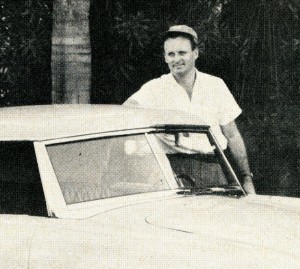
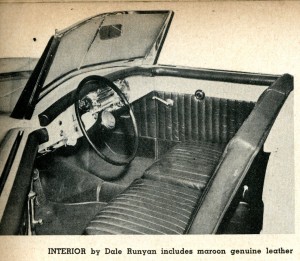
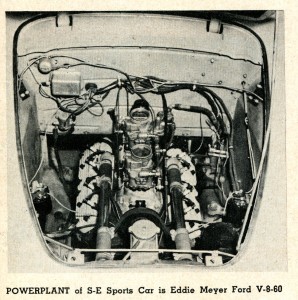
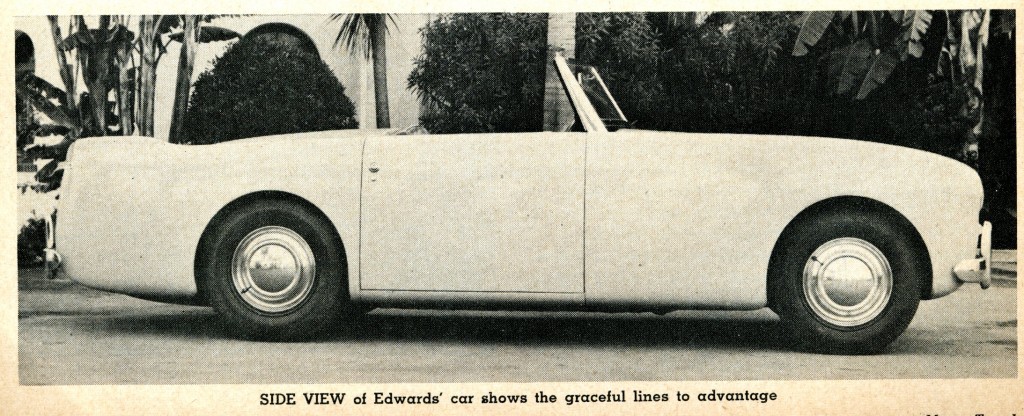


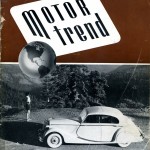
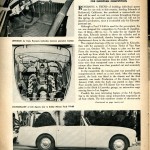
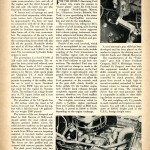
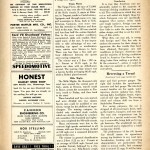
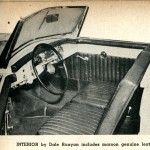
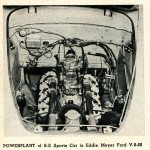
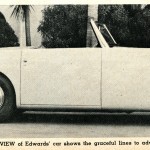
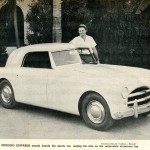
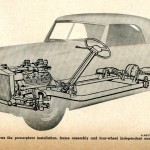
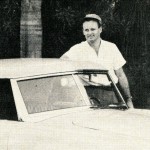

I get a charge out of the description of lifting spatial dimensions of a model with a pantograph device that must have multiplied it times four. Seems like a lot of attention to little purpose — no bodyshell prior to the 1953 Stude or some Ferraris exhibited shapes any more complicated than a simple bathtub, including this Edwards. Later Edwards had a bit more character.
I don’t remember of ever seeing pictures of this car.It really has an interesting chassis design.one that might be pretty good even for todays time .The next Edwards design was the one I remember seeing..I thought it was way ahead of it’s time.
Mel
Hi Geoff and Others:
If memory serves me correctly, the great mechanic and technician Phil Remington worked on this car with Sterling Edwards. I can forward to anyone who would like a copy, of the interview I did with Phil some time ago. Phil is an artist as much as a techy and people who know him, like Warren Olson say he could do up a crossflow manifold for a set of Weber carburetors in no time flat. It is also interesting that the Ford V-8 ’60’ engine was used too. Warren told me how he and other California hot rodders were able to eliminate the overheating problems which L Head Ford V-8s could experience when they were worked hard, i.e. racing whether street, drag or road racing. I interviewed Warren as well and again if anyone would like a copy of the interviews they can email me or look for old issues of Vintage Racecar – or email Casey Annis at Vintage Racecar to get a subscription or old issues – free advt.
Cheers,
John R. Wright
The “exact scale wooden model” spoken about in the article, was a 1/4 scale and had a removable ‘boattail’ style hardtop which looked really neat. Somewhere along the way it must have been decided that the design might be too heavy for easy removal.
Glenn
I recall reading about an Edwards with what I thought was an Ardun conversion on the V8-60 block. I have not heard of a Timms OHV. The V8-60 Ardun came out after the “big block” conversions, so perhaps Edwards/Timm were the incentive for the Ardun product. Only about a dozen sets for the 60 are known to exist.